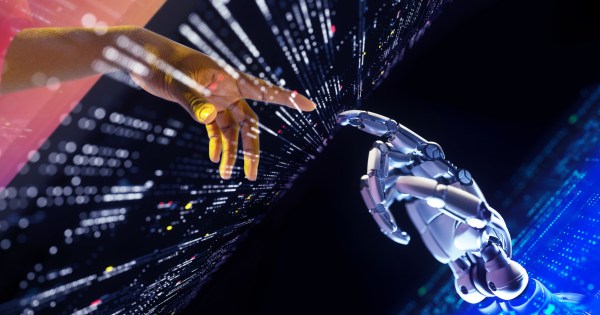In an uncertain world, brands want to present as warming, positive presences in society, and their visual strategies should reflect this. That means looking beyond what the movies tell us the future will be and depicting the one we’re actually shaping.
The visual code of hands
While showing people using computers, smartphones, and even speculative tech like holograms are common ways to humanize tech in visuals, Getty Images’ search data shows that users are fixated on hands.
As seen in the image above, the focal point is not the futuristic glowing keyboard, but the extension of the user’s finger to press a key. The visual signals human influence over technology, evoking a sense of autonomy and control.
The emphasis on hands is also a response to the rapid proliferation of AI imagery. Hands are a popular litmus test of whether an image is AI-generated, since generative models struggle to capture them. In this sense, hands are becoming the AI era’s symbol of trust and authenticity.
But as more brands incorporate AI into their creative workflows, a simple “hand test” is not enough where transparency is concerned. Labeling AI-generated and -modified content will prevent audiences from feeling duped or misled. To build further trust with audiences, brands should use AI tools that are responsibly trained off permissioned content, ideally ones that compensate the creators who offer their work. This reduces potential legal risk to the brand while reinforcing the unassailable value of human creativity.
Picturing a human future
Our relationships with technology are deeply personal. Most of us interface with software in some capacity every day, be it at work, school, or for leisure. 91% of Americans own a smartphone. However, depicting the personal utility of technology like smartphones and laptops is not where brands struggle—it’s emerging technologies like AI that are driving them back toward the blues.
AI is difficult to visualize, and by leaning into clinical, scientific visuals ornamented with fiber-optic patterns and overlays, marketers are trying to capture the feeling of using advanced technology. But everyday people aren’t using AI in a high-tech laboratory; if brands want to resonate with users, they need to bring the future home, embracing more vibrant, energetic visual styles.


